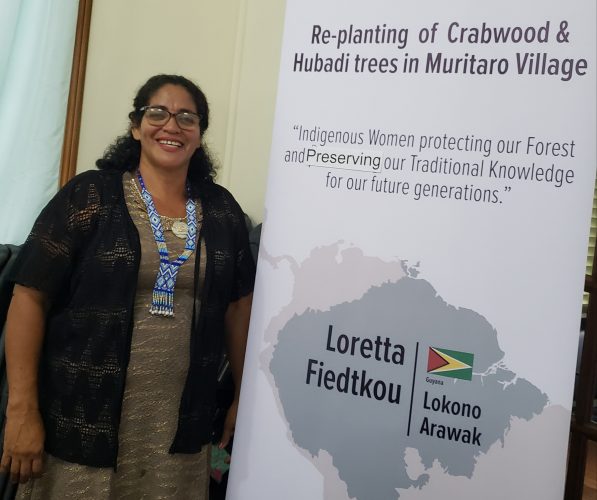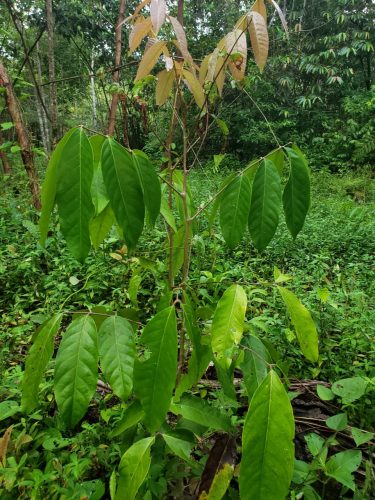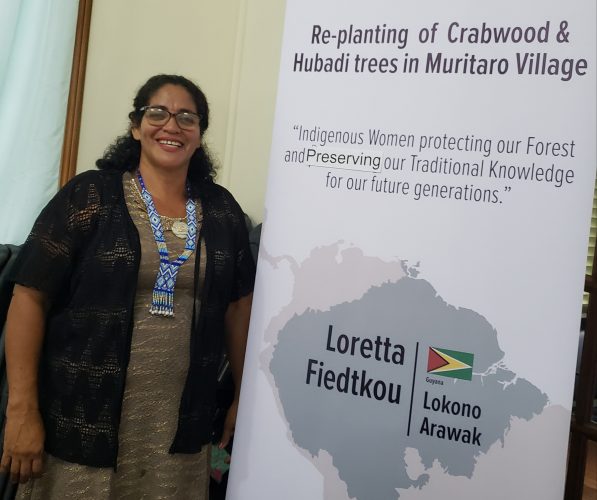Loretta Fiedtkou planted 176 crabwood seedlings in her farmland a year ago in a bid to encourage the replanting of the dwindling hardwood species that is harvested for logs.
Fiedtkou, 55, a former logger turned conservationist and former toshao of Muritaro Village in the Upper Demerara River, expects her first yield of crabwood seeds in three years, four years from planting.
She is one of five Indigenous Women’s fellows on the Amazon Indigenous Women’s Fellowship Program from which she received a $2 million-grant funding for the reforestation of crabwood trees. The programme is sponsored by Conservation International in collaboration with the National Toshaos Council.
“Through this project I am doing leadership, business management, public speaking and capacity building,” she told Stabroek Weekend.
Why crabwood trees? The crabwood tree is one of Guyana’s top ten leading wood species for which there is great demand and has more value added products than other hardwood species she said. The crabwood tree is a durable wood used in the construction industry and the seeds are known for the therapeutic ‘crab oil’ that is used for rashes, other ailments and cosmetics.
“Growing up, my grandmother always made ‘crab oil’ from the crabwood seeds for home use and the remainder she sold. I learned from her. Every season when the seeds fall to the ground I gather a bagful or two to make crab oil.”
Prior to her current project, Fiedtkou had planted a crabwood tree in her yard and within four years it started bearing fruit.
One year some women in the village reported to her they could no longer harvest crabwood seeds in the forest because all the trees were cut down by loggers.
“These women depended on the seeds of the crabwood trees to make oil to earn an extra dollar during the season. I used to gather the seeds in the forest, too. As a village we decided to stop cutting down the crabwood trees.”
When the National Toshaos Council and Conservation International advertised a fellowship for eligible Indigenous Women to take part, Fiedtkou submitted her application two days before the deadline. She was successful.

For Fiedtkou the crabwood tree serves many purposes. The broad leaves capture more carbon dioxide and its durable wood is used for housebuilding, furniture and craft.
“Apart from crab oil, we make facial creams, soaps and candles and a cream for ring worms and other rashes. We also boil the bark for rashes and bathe in it. It helps.”
She did not get the full support for her project from villagers because it was the first time someone has been doing reforestation in the community. “We need results right away. Four years is long term. We only look at logging. I hope this can inspire and encourage villagers to earn in different ways. I was a former logger myself.”
The Forestry Division is expected to monitor the growth and development of the plants from this month end. Another woman in the community has planted six seedlings that are also growing well.
The fellowship took Fiedkou and other fellows from other Amazonian countries to Ecuador in April this year and they were exposed to the works of other fellows.
Going solar
A pioneer and a go-getter, Fiedtkou recommended the use of solar panels to provide energy for riverain communities in Region Ten (Upper Demerara/Upper Berbice). Muritaro was the first community to have solar panels installed in each home in the government’s pilot project.
“I was asked to accompany a team doing a feasibility study to provide electricity to the communities. They were looking at generating electricity by windmill, generators and hydropower. When the head of the team doing the study was writing his report, he said to me, ‘I don’t know what else to use.’ Generators can’t work because of the layout of homestead along the bank of both rivers, there is not sufficient wind for windmills and there are no nearby waterfalls to obtain hydro power’.”

Fiedtkou, who was then toshao of Muritaro, recommended the use solar panels. He told her, “‘They did not ask me about solar panels but I can make that recommendation.’ He made the recommendation and it was accepted.”
Muritaro was the first pilot community of five where solar panels were installed initially. “Mention was never made of the fact that it was me who made that recommendation. Nevertheless, I am happy so many people in my village have benefitted. That was my reward and then other communities followed. The whole country now is involved in the solar project. I think I made a great impact in Guyana by recommending the use of solar panels.”
Married, and the mother of four children, Fiedtkou was born and raised in Muritaro, a riverain community 25 miles from Linden in the Upper Demerara River. It is accessible by river. It has an itinerant population of about 300 as people migrate looking for better education and jobs.
Muritaro has been in existence since the 1800s. Fiedtkou’s paternal grandfather was born there in 1909 and attended the then Anglican school there.
“I farmed and went logging with my parents in the creek. My paternal grandmother was into handicraft. All of my childhood Indigenous knowledge, such as cutting the ite palm leaf, stripping the tibisiri, boiling and drying it to make craft, I learned from her.
“I know a little about the mucru, not that much. I know to make the maswa (fish trap) and quake. I can knit seines for fishing. I crochet and I do nine different embroidery stitches. I sew all my children, grandchildren clothes and whoever asked me to sew clothes for them. I know to use the cutlass, brush cutter, chain saw, axe, everything. I tell you these things because I told myself that anywhere I go and I have to earn my living. I must be able to survive using my knowledge.”
Muritaro’s first toshao
Prior to Fiedtkou becoming Muritaro’s first toshao, Fiedtkou was the chairperson of the community development council (CDC), which was in place before Muritaro was given land title. She was in the forefront seeking title for the community “because the whole place where we are now living was taken up by coastlanders. So if you didn’t get permission from the coastlander and you cut wood and if their rangers caught you, you lose the logs, you lose your money, you lose everything. Because of that, a lot of youngsters, including my brothers left the village and sought jobs elsewhere.
“Growing up I never knew about malaria. As I grew older we had an outbreak of malaria in the community. When we did the research, we found it was brought in by the men who went to work in the mining areas and returned to the village.”

After she became chairperson of the Community Development Council (CDC) in 2004, one of the council’s priorities was obtaining title to their land and managing their affairs. The council held discussions with the then Minister of Amerindian Affairs, Carolyn Rodrigues-Birkett, and followed up their proposal in writing.
In 2005 at the toshaos conference in Mainstay in Region Two – Pomeroon/Supenaam, she was sworn in as a toshaos prior to Muritaro being granted its land title in 2007.
Sacrifices
When her children were young she joined her husband in the upper reaches of the Demerara where she learned to spin the batel to find gold and ‘to throw a spade.’ “I told myself if a man can do it, I can’t do it too.”
When they started school she got into logging and farming crops and poultry.
When her eldest daughter secured a place at Christianburg Wismar Secondary School in Linden after writing common entrance, Fiedtkou rented a place in Wismar to ensure her daughter gained a secondary education.
“A lot of people never allowed their children to come out for secondary school. I told myself my parents never gave me that opportunity and I am going to cross the bridge many people did not want to cross. So I went to Linden, did domestic work with a doctor for some time and worked at the Star Bonnet Hotel while my children went to school.”
Shortly after her younger daughter and her last son were in Linden also attending secondary school.
“There were a lot of comments about why I left my husband at home with my first son and third child who has cerebral palsy. Someone told me I was a mad woman to go away with my children and leave my husband at home. My husband was very supportive even with my community work. I was with my younger son until he was in the higher forms in secondary school when he stayed with a guardian.”
She continued, “I made that sacrifice for my children to get a secondary education. Other parents decided if Loretta could make it they could make it too. In spite of negative comments, it did make an impact for children to get a secondary education.”
Fieldkou’s eldest daughter is now the acting head teacher of the school in Muritaro and the second daughter has her own business in Coomacka. Her last son also runs his own business in the community.
During her spare time in Wismar she took some courses in floral arrangement and cake decorating that were offered by Silver City Secondary where another of her children attended. She had also done a course in business management. After her daughters wrote their Caribbean Secondary Education Certificate examinations, she returned fulltime to Muritaro.
“We were rearing chickens. My husband was left with the chicken and the farm. Every weekend I went home. We came out on Monday mornings returned on Friday afternoons. We went to church on Saturdays and farmed on Sundays and back out on Monday. It was a challenging experience but I did it.”
Speaking about her 31-year-old son with cerebral palsy, Fiedtkou said, “He is very determined like his mother. He walks, feeds and bathes himself. Although he never went to school, he is skillful and creative in craft and makes cutting/kneading boards for people. He earns. He is not just lying there doing nothing. He has a computer and he uses his toes a lot. You can imagine what he does with his toes on that computer. He does a lot of things including putting music on flash drives for people. He uses his left hand and toes more because his right hand is immobile.
After she returned to Muritaro she was elected the CDC chairperson in 2004 and the toshao in 2005. Her focus was on village improvement and village forestry plans. She served one term as toshao and took a break until 2015 when she was re-elected and served until 2020.
“As a council we built walkways, benabs, boats, refurbished the village office and other small projects for the village.” Currently she is not on the council due to term limits.
During her tenure as toshao, she undertook a number of training programmes in relation to women and gender, domestic violence, child development, leadership and management, mental health and social protection.
It has not always been easy in the village. “With the titling of the land, I got a fight down but I held out. At the end of the day, the villagers accepted and now they appreciate what was done. When I told them we were going to get a landline in the village from GT&T in 2007, they were like, in which dream you talked about a phone to come in this village. When GT&T put down the phone they saw it happening.”
She was representative for the restorative justice committee and served on the NTC executive as assistant secretary/treasurer from 2018 to 2020. She was previously a commissioner on the Family Life Commission. At present she is a member of the Juvenile Justice Board and the local Indigenous Peoples representative on the board of the Guyana Extractive Industries Transparency Initiative.
Fiedtkou was instrumental in getting Muritaro as the pilot community in the National Opt-In Mechanism package which was part of Guyana’s Low Carbon Development Strategy (LCDS) which was launched in 2009. The LCDS sought to create a low deforestation, low carbon, climate resilient economy to combat climate change.






